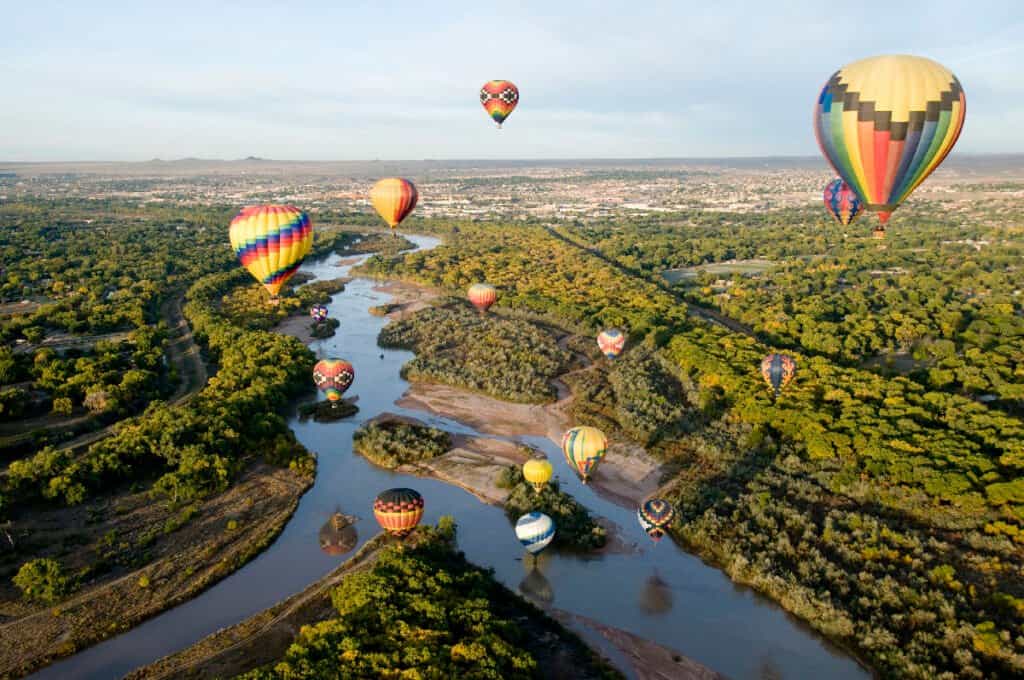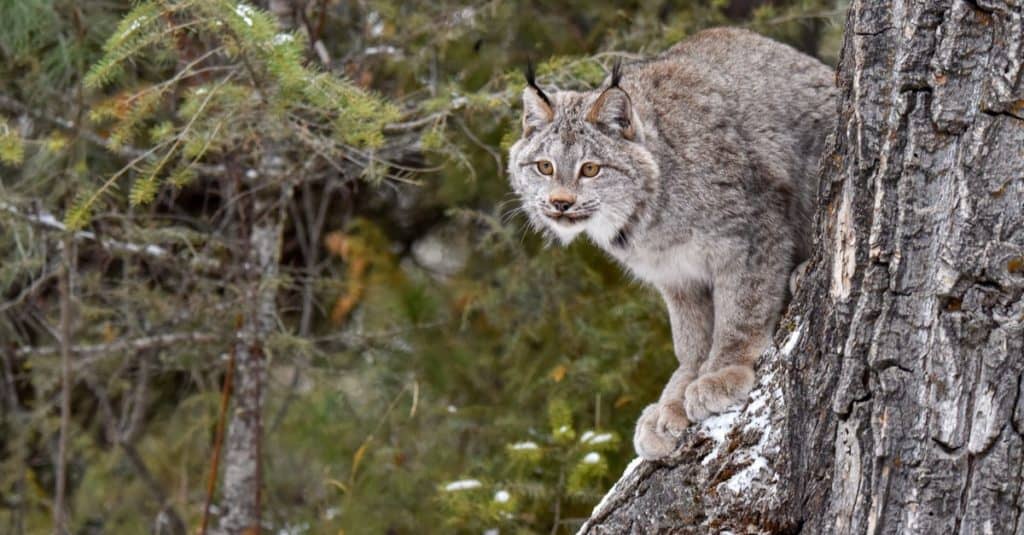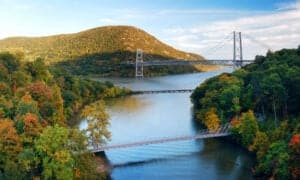How Wide is the Rio Grande River at Its Widest Point?
The Rio Grande River travels from the U.S., acts as the border between Texas and Mexico, and eventually flows out into the Gulf of Mexico. Because this river crosses many arid regions, it is a significant source for irrigation. The river supplies so much water to surrounding areas as it flows towards the sea that only 20% of its water makes it to the Gulf of Mexico.
The Rio Grande River is also an American Heritage River, with two parts of the river falling under the preservation of the National Wild and Scenic Rivers System. If the river irrigates so much of the land through which it passes, it is difficult not to wonder how wide is the Rio Grande River at its widest point.
The Width of the Rio Grande River

iStock.com/Greg Meland
The Rio Grande River is roughly 328 feet wide. It originates in Colorado and ends when it meets the Gulf of Mexico, traveling a distance of approximately 1,900 miles. This distance makes the Rio Grande River the fourth-longest river in the U.S. and the fifth-longest in North America.
The Course of the Rio Grande River
The Rio Grande River‘s headwaters are in the Rio Grande National Forest, Colorado. Several streams meet at the bottom of Canby Mountain in this forest, creating the source of the Rio Grande.
From there, it travels through the Luis Valley before forming the Rio Grande Gorge and White Rock Canyon in New Mexico. Then, it flows through the Rio Grande Rift and supports the bosque ecosystem in the Rio Grande Rift’s floodplain.
Far from over, the Rio Grande River then streams through Albuquerque to Las Cruces and on to Texas. Once it reaches El Paso, it forms the border between the U.S. and Mexico.
One of the river’s largest tributaries, the Río Conchos, joins the Rio Grande below El Paso. Next, the Rio Grande River travels through the Big Bend National Park in Texas before entering the desert. After exiting the desert, the river enters a delta and empties into the Gulf of Mexico.
Tributaries of the Rio Grande River
The primary tributary of the Rio Grande River is the Río Conchos River. Other tributaries which contribute to the Rio Grande include:
- The Pecos River
- Devils Rivers
- The Chama River
- The Puerco River
- The Salado River
- The San Juan River
The Economy Along the Rio Grande River
The Rio Grande River has a selection of springs providing groundwater to nearby communities. Most of these springs are in Hot Springs, Big Bend National Park, and the town of Del Rio.
Also, the Rio Grande River basin is ideal for generating hydroelectricity. Consequently, the reservoirs in the basin are the Falcon Reservoir, Lake Toronto, which La Boquilla Dam impounds, Elephant Butte, Marte Gómez reservoir, Venustiano Carranza, and the international Amistad Dam.
Besides providing groundwater, the Rio Grande River’s basin supports the cultivation of crops on two million acres of land. Typical crops that farmers cultivate include:
- Potatoes
- Alfalfa
- Cotton
- Pecans
- Grapes
- Citrus Fruit
The river also supports a thriving mining industry. Materials like petroleum, natural gas, coal, uranium ore, silver, lead, gold, potash, and gypsum are mined and harvested in the basin. For residents and tourists, the Rio Grande River and its basin provide recreational spaces where people can visit national and state parks and monuments, go rafting, and even fish and hunt.
The Name and its Meaning
The Rio Grande is a Spanish name and means the “Big River.” When the river is referred to as the Río Grande del Norte, it translates to the “Great River of the North.” In Mexico, its name is different, with locals calling it the Río Bravo or Río Bravo del Norte. “Bravo” in Spanish means fierce or brave.
But that’s not where the names for this river end. Different parts of the river also have other names. For example, the upper Rio Grande River is also known as the Rio del Norte. This name comes from the Spanish colonial times to the mid-nineteenth century. The name changed to the Rio Grande when early American colonizers settled in Texas.
By the close of the 19th century, the entire river became commonly known as the Rio Grande River. Also, the lower Rio Grande was known as the Rio Bravo in the early 1600s. Besides these names, the Rio Grande River has had many others over the centuries, including:
- Keresan, Tewa, and Tiwa, all translating to the “Big River.”
- Towa, which translates into the “Great Waters.”
- Navajo, which translates into the “Female River.” According to Navajo cosmology, the south indicates female energy. So, because the Rio Grande flows in a southerly direction, their name for it was the Female River.
Wildlife Along the Wide Rio Grande River

Evelyn D. Harrison/Shutterstock.com
The Rio Grande River originates from a snowy mountain stream and eventually travels through a desert before ending in the Gulf of Mexico. The river’s course traverses through various climates and ecosystems, so the wildlife also differs at different stages of the river’s route.
Carnivorous wildlife in the upper Rio Grande River region includes the Canada lynx, black bear, and cougar. Other mammals found in the area are the Rocky Mountain bighorn sheep, mule deer, Rocky Mountain elk, and pronghorn. In addition, the Rio Grande cutthroat trout is a common sighting in this river and is the state fish of New Mexico.
The lower Rio Grande River region is incredibly diverse, featuring 1,200 plant types, 300 butterfly species, and over 700 kinds of vertebrates. At least 520 of these vertebrates are bird species.
This area is home to weird creatures like the rare speckled racer snake and the rare southern yellow bat. Famously, the site is also a roosting and feeding ground for migrating geese, waterfowl, shorebirds, and sandhill cranes. The lower part also has close to 1,000 species of beetles that maintain plant pollination.
More from A-Z Animals
The Rio Grande River travels from the U.S., acts as the border between Texas and Mexico, and eventually flows out into the Gulf of Mexico. Because this river crosses many arid regions, it is a significant source for irrigation. The river supplies so much water to surrounding areas as it flows towards the sea that only 20% of its water makes it to the Gulf of Mexico.
The Rio Grande River is also an American Heritage River, with two parts of the river falling under the preservation of the National Wild and Scenic Rivers System. If the river irrigates so much of the land through which it passes, it is difficult not to wonder how wide is the Rio Grande River at its widest point.
The Width of the Rio Grande River

iStock.com/Greg Meland
The Rio Grande River is roughly 328 feet wide. It originates in Colorado and ends when it meets the Gulf of Mexico, traveling a distance of approximately 1,900 miles. This distance makes the Rio Grande River the fourth-longest river in the U.S. and the fifth-longest in North America.
The Course of the Rio Grande River
The Rio Grande River‘s headwaters are in the Rio Grande National Forest, Colorado. Several streams meet at the bottom of Canby Mountain in this forest, creating the source of the Rio Grande.
From there, it travels through the Luis Valley before forming the Rio Grande Gorge and White Rock Canyon in New Mexico. Then, it flows through the Rio Grande Rift and supports the bosque ecosystem in the Rio Grande Rift’s floodplain.
Far from over, the Rio Grande River then streams through Albuquerque to Las Cruces and on to Texas. Once it reaches El Paso, it forms the border between the U.S. and Mexico.
One of the river’s largest tributaries, the Río Conchos, joins the Rio Grande below El Paso. Next, the Rio Grande River travels through the Big Bend National Park in Texas before entering the desert. After exiting the desert, the river enters a delta and empties into the Gulf of Mexico.
Tributaries of the Rio Grande River
The primary tributary of the Rio Grande River is the Río Conchos River. Other tributaries which contribute to the Rio Grande include:
- The Pecos River
- Devils Rivers
- The Chama River
- The Puerco River
- The Salado River
- The San Juan River
The Economy Along the Rio Grande River
The Rio Grande River has a selection of springs providing groundwater to nearby communities. Most of these springs are in Hot Springs, Big Bend National Park, and the town of Del Rio.
Also, the Rio Grande River basin is ideal for generating hydroelectricity. Consequently, the reservoirs in the basin are the Falcon Reservoir, Lake Toronto, which La Boquilla Dam impounds, Elephant Butte, Marte Gómez reservoir, Venustiano Carranza, and the international Amistad Dam.
Besides providing groundwater, the Rio Grande River’s basin supports the cultivation of crops on two million acres of land. Typical crops that farmers cultivate include:
- Potatoes
- Alfalfa
- Cotton
- Pecans
- Grapes
- Citrus Fruit
The river also supports a thriving mining industry. Materials like petroleum, natural gas, coal, uranium ore, silver, lead, gold, potash, and gypsum are mined and harvested in the basin. For residents and tourists, the Rio Grande River and its basin provide recreational spaces where people can visit national and state parks and monuments, go rafting, and even fish and hunt.
The Name and its Meaning
The Rio Grande is a Spanish name and means the “Big River.” When the river is referred to as the Río Grande del Norte, it translates to the “Great River of the North.” In Mexico, its name is different, with locals calling it the Río Bravo or Río Bravo del Norte. “Bravo” in Spanish means fierce or brave.
But that’s not where the names for this river end. Different parts of the river also have other names. For example, the upper Rio Grande River is also known as the Rio del Norte. This name comes from the Spanish colonial times to the mid-nineteenth century. The name changed to the Rio Grande when early American colonizers settled in Texas.
By the close of the 19th century, the entire river became commonly known as the Rio Grande River. Also, the lower Rio Grande was known as the Rio Bravo in the early 1600s. Besides these names, the Rio Grande River has had many others over the centuries, including:
- Keresan, Tewa, and Tiwa, all translating to the “Big River.”
- Towa, which translates into the “Great Waters.”
- Navajo, which translates into the “Female River.” According to Navajo cosmology, the south indicates female energy. So, because the Rio Grande flows in a southerly direction, their name for it was the Female River.
Wildlife Along the Wide Rio Grande River

Evelyn D. Harrison/Shutterstock.com
The Rio Grande River originates from a snowy mountain stream and eventually travels through a desert before ending in the Gulf of Mexico. The river’s course traverses through various climates and ecosystems, so the wildlife also differs at different stages of the river’s route.
Carnivorous wildlife in the upper Rio Grande River region includes the Canada lynx, black bear, and cougar. Other mammals found in the area are the Rocky Mountain bighorn sheep, mule deer, Rocky Mountain elk, and pronghorn. In addition, the Rio Grande cutthroat trout is a common sighting in this river and is the state fish of New Mexico.
The lower Rio Grande River region is incredibly diverse, featuring 1,200 plant types, 300 butterfly species, and over 700 kinds of vertebrates. At least 520 of these vertebrates are bird species.
This area is home to weird creatures like the rare speckled racer snake and the rare southern yellow bat. Famously, the site is also a roosting and feeding ground for migrating geese, waterfowl, shorebirds, and sandhill cranes. The lower part also has close to 1,000 species of beetles that maintain plant pollination.





